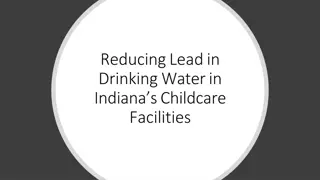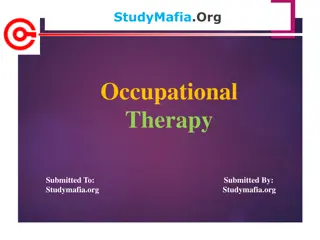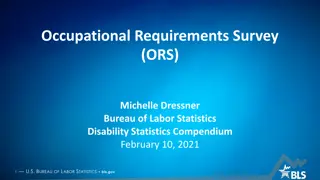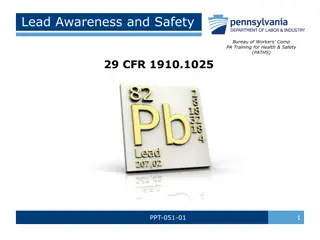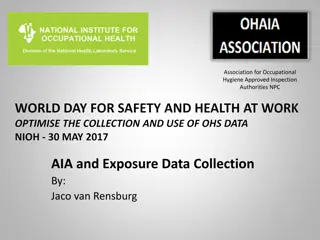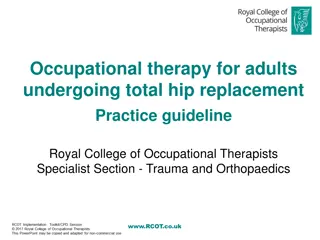Historical Occupational Exposures to Lead in Pre-Industrialized Times
Occupational exposure to lead in pre-industrialized times dates back to ancient eras, with Romans and artisans using lead in various applications. Lead toxicity was observed early on, with artisans like goldsmiths and artists being at risk. Physicians in the Renaissance era recognized the dangers of lead exposure, advising precautions for miners and metalworkers. The understanding of lead's toxic effects evolved over time, shaping occupational safety practices.
Uploaded on Sep 24, 2024 | 0 Views
Download Presentation

Please find below an Image/Link to download the presentation.
The content on the website is provided AS IS for your information and personal use only. It may not be sold, licensed, or shared on other websites without obtaining consent from the author. Download presentation by click this link. If you encounter any issues during the download, it is possible that the publisher has removed the file from their server.
E N D
Presentation Transcript
Lead in the Environment Unit 1, Class 2: Occupational Exposures
Lead in pre-industrialized times Roman era, I Lead is one of first metals humans learned to use due to ease of extraction, ductility Lead toxicity first documented as early as 2nd century, BCE Acute effects (paralysis, saturnine colic) associated with high-dose lead exposure Nicander of Colophon, Hellenistic physician Not defined clinically; lack of interest in disease possibly due population exposed typically artisans who were low socio- economic class
Lead in pre-industrialized times Roman era, II 1st century BC, expanded use of lead due to Roman conquest of Britain, where ore was rich in lead Common lead exposures Lead in water Water and sanitation pipes very sophisticated, and lined with lead! But water heavily mineralized with calcium carbonate, which would have coated pipes and formed strong protection against release of lead salts Lead in wine Wine used sapa, a reduction of must (grape juice reduced to a syrup), that was prepared in lead containers Lead acetate (also called lead sugar ) used to sweeten low quality wines Wines also stored in lead-lined amphora
Lead in pre-industrialized times Renaissance era, I Occupational use of lead by artisan class (which earned greater respect in this period): Artists (use of cerussite, also known as lead carbonate or white lead ) Fine metalworkers, especially goldsmiths Alchemists Possible victims of lead poisoning Piero della Francesca (c. 1416-1492) Rembrandt (1606-1669) Francisco Goya (1746-1828)
Lead in pre-industrialized times Renaissance era, II Increased understanding of occupational lead toxicity Ulrich Ellenbog, German physician, 1440-1499, guided metalsmiths to not breathe in metal fumes Georgius Bauer (also known as Agriciola), Saxon physician, 1494-1556, studied health problems of German miners Paracelsus, German-Swiss physician, 1493-1541, Use of lead as pharmaceutical, Dose makes the poison (contested) Samuel Stockhausen, German physician, 1656, advised German miners to avoid aspiration of dust Bernardino Ramazzini, Italian physician, 1633-1714, identified all lead processes for metalworkers, and all mining activities, as dangerous, resulting in palsied hands, abdominal colic, fatigue, cachexia, edentulism (loss of teeth)
Lead in pre-industrialized times Non-occupational etiology of lead Lead exposure from ingestion: Eberhard Gockel, German physician, 1636-1703, linked colica pictonum an intensely painful disease involving GI tract frequently resulting in death to lead levels in wine Sir George Baker, British physician, 1722-1809, linked Devonshire cholic to ingestion of lead Johann Peter Frank, German hygienist, 1745-1821, recommended avoiding water flowing from lead pipes
Lead in industrialized era Linking lead exposure to symptoms Louis Tanquerel des Planches, French physician, 1810-1862, examined 1200 cases of lead poisoning at H pital de la Charit , Paris, finding disease more common in those working with lead fumes than solid lead, and identified neuropsychiatric manifestations of lead poisoning Ren Laennec, French physician, 1781-1826, identified anemia with occupational exposure to lead Henry Burton, British neurologist, 1799-1849, identified blue-purple line along gumline as symptom of occupational exposure to lead Sir Alfred Baring Garrod, physician, 1819-1907, linked occupational lead poisoning to gout Jean- tienne Dominique Esquirol, 1772-1840,and then Daniel Hack Tuke, 1795-1833, both documented mental disorders associated with chronic low-dose occupational exposures of lead
Lead in the industrialized era Occupational protections Charles Turner Thackrah, British advocate, 1795-1833, efforts to improve worker conditions resulted in legislation to remove and replace harmful agents in the production cycle Children forbidden to work in white lead factories in Britain, 1878 Factories Act: Prevention of Lead Poisoning, 1883, British Parliament took steps to reduce exposure within occupational setting White Lead Painting Convention, International Labor Office, Geneva, 1921, treaty to ban indoor use of paint (not ratified by Britain or US) Lead Poisoning and Lead Absorption, Treatise by Sir Thomas Morrison Legge, 1863-1932, and Sir Kenneth Weldon Goadby, 1873-1958 on occupational risks from lead exposure
Modern era Childhood exposure to lead paint Childhood exposure to residual lead has brought about key scientific and legislative advances 1887: US first documents childhood lead poisoning. 1904: John Lockhart Gibson, Australian physician, 1860-1944, childhood lead poisoning linked to domestic lead exposure from leaded paints. 1909: France, Belgium, Austria ban use of white lead interior paint. 1914: Australia restricts use of lead in paints. 1922: League of Nations bans white-lead interior paint. US declines to adopt. 1922: Tunisia and Greece ban white-lead interior paint. 1926: Great Britain, and Sweden, ban white lead interior paint. 1927: Poland bans white lead interior paint. 1931: Spain and Yugoslavia ban white lead interior paint. 1978: US bans lead in interior paints.
Modern Era Exposure to lead from gasoline Corporate interests, weak US economy, and wartime needs stymied US efforts 1920: General Motors engineer Thomas Midgely, Jr. (1889-1944) identified anti-knock effect of tetra-ethylene lead (TEL) when added to gasoline and formally introduces leaded gas into commercial sales 1923: First tetraethyl lead poisoning deaths occur 1980: National Academy of Sciences calls leaded gasoline greatest source of atmospheric lead pollution 1980s-90s: Benzene used to replace TEL in gasoline 1986: TEL banned from gasoline for cars and trucks in US 1995: TEL banned from all US land vehicles (small aircraft avgas still exempt, phased out by 2030)



